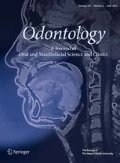Abstract
The objective of this study was to determine the inhibitory effect of alpha-mangostin on Candida biofilms. Candida species including Candida albicans, Candida krusei, Candida tropicalis, and Candida glabrata were tested. Candida biofilms were formed in flat-bottomed 96-well microtiter plates. The metabolic activity of cells within biofilms was quantified using the XTT assay. The results demonstrated that alpha-mangostin showed a significant anti-biofilm effect on both developing biofilms and preformed biofilms of Candida species. It may be concluded that alpha-mangostin could be an anti-biofilm agent against Candida species. Further in vivo investigations are needed to uncover the therapeutic values of this medicinal plant.


References
Williams DW, Kuriyama T, Silva S, Malic S, Lewis MA. Candida biofilms and oral candidosis: treatment and prevention. Periodontol 2000. 2011;55(1):250–65.
Sanchez-Vargas LO, Estrada-Barraza D, Pozos-Guillen AJ, Rivas-Caceres R. Biofilm formation by oral clinical isolates of Candida species. Arch Oral Biol. 2013;58(10):1318–26.
ten Cate JM, Klis FM, Pereira-Cenci T, Crielaard W, de Groot PW. Molecular and cellular mechanisms that lead to Candida biofilm formation. J Dent Res. 2009;88(2):105–15.
Niimi M, Firth NA, Cannon RD. Antifungal drug resistance of oral fungi. Odontology. 2010;98(1):15–25.
Rautemaa R, Ramage G. Oral candidosis-clinical challenges of a biofilm disease. Crit Rev Microbiol. 2011;37(4):328–36.
Negri M, Salci TP, Shinobu-Mesquita CS, Capoci IR, Svidzinski TI, Kioshima ES. Early state research on antifungal natural products. Molecules. 2014;19(3):2925–56.
Jindarat S. Xanthones from mangosteen (Garcinia mangostana): multi-targeting pharmacological properties. J Med Assoc Thai. 2014;97(Suppl 2):S196–201.
Gopalakrishnan G, Banumathi B, Suresh G. Evaluation of the antifungal activity of natural xanthones from Garcinia mangostana and their synthetic derivatives. J Nat Prod. 1997;60(5):519–24.
Kaomongkolgit R, Jamdee K, Chaisomboon N. Antifungal activity of alpha-mangostin against Candida albicans. J Oral Sci. 2009;51(3):401–6.
Yiemwattana I, Kaomongkolgit R. Alpha-mangostin suppresses IL-6 and IL-8 expression in P. gingivalis LPS-stimulated human gingival fibroblasts. Odontology. 2015;103(3):348–55.
Kaomongkolgit R. Alpha-mangostin suppresses MMP-2 and MMP-9 expression in head and neck squamous carcinoma cells. Odontology. 2013;101(2):227–32.
Taweechaisupapong S, Aiemsaard J, Chitropas P, Khunkiti W. Inhibitory effect of lemongrass oil and its major constituents on Candida biofilm and germ tube formation. S Afr J Bot. 2012;81:95–102.
Costa AC, Pereira CA, Freire F, Junqueira JC, Jorge AO. Methods for obtaining reliable and reproducible results in studies of Candida biofilms formed in vitro. Mycoses. 2013;56(6):614–22.
Al-Massarani SM, El Gamal AA, Al-Musayeib NM, Mothana RA, Basudan OA, Al-Rehaily AJ, et al. Phytochemical, antimicrobial and antiprotozoal evaluation of Garcinia mangostana pericarp and α-mangostin, its major xanthone derivative. Molecules. 2013;18(9):10599–608.
Mohamed GA, Ibrahim SR, Shaaban MI, Ross SA. Mangostanaxanthones I and II, new xanthones from the pericarp of Garcinia mangostana. Fitoterapia. 2014;98:215–21.
Thein ZM, Samaranayake YH, Samaranayake LP. In vitro biofilm formation of Candida albicans and non-albicans Candida species under dynamic and anaerobic conditions. Arch Oral Biol. 2007;52(8):761–7.
Rossoni RD, Barbosa JO, Vilela SF, dos Santos JD, de Barros PP, Prata MC, et al. Competitive interactions between C. albicans, C. glabrata and C. krusei during biofilm formation and development of experimental candidiasis. PLoS One. 2015;10(7):e0131700.
Obolskiy D, Pischel I, Siriwatanametanon N, Heinrich M. Garcinia mangostana L.: a phytochemical and pharmacological review. Phytother Res. 2009;23(8):1047–65.
Martins N, Barros L, Henriques M, Silva S, Ferreira I. Activity of phenolic compounds from plant origin against Candida species. Ind Crops Prod. 2015;74:648–70.
Torrungruang K, Chutimaworapan S. Effect of mangosteen pericarp extract on cell viability in human gingival fibroblasts. CU Dent J. 2006;29:75–82.
Sampath D, Vijavaraghavan K. Cardioprotective effect of alpha-mangostin, a xanthone derivative from mangosteen on tissue defense system against isoproterenol-induced myocardial infarction in rats. J Biochem Mol Toxicol. 2007;21:336–9.
Rassameemasmaung S, Sirikulsathean A, Amornchat C, Hirunrat K, Rojanapanthu P, Gritsanapan W. Effects of herbal mouthwash containing the pericarp extract of Garcinia mangostana L on halitosis, plaque and papillary bleeding index. J Int Acad Periodontol. 2007;9:19–25.
Acknowledgments
This work was supported by the grants from Naresuan University (Research grants from income of fiscal year 2014, the Grant Number: R2557C106). The authors would like to thank Assistant Professor Dr. Weeraya Tantanapornkul, instructor of Faculty of Dentistry, and Mr. Arthur John Pollock, instructor of Faculty of Humanities, Naresuan University, for editing the manuscript.
Author information
Authors and Affiliations
Corresponding author
Ethics declarations
Funding
This work was supported by the grants from Naresuan University (Research grants from income of fiscal year 2014, the Grant Number: R2557C106).
Conflict of interest
The authors declare that they have no conflict of interest.
Rights and permissions
About this article
Cite this article
Kaomongkolgit, R., Jamdee, K. Inhibitory effect of alpha-mangostin on Candida biofilms. Odontology 105, 248–253 (2017). https://doi.org/10.1007/s10266-016-0256-3
Received:
Accepted:
Published:
Issue Date:
DOI: https://doi.org/10.1007/s10266-016-0256-3

